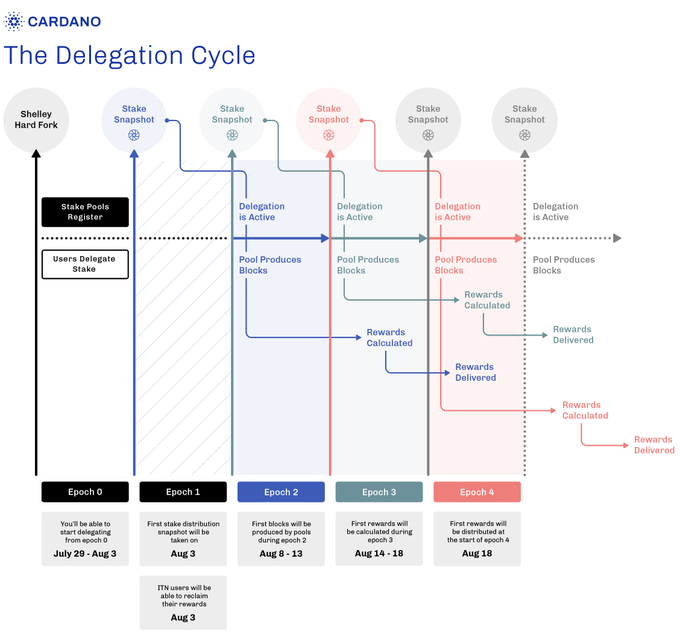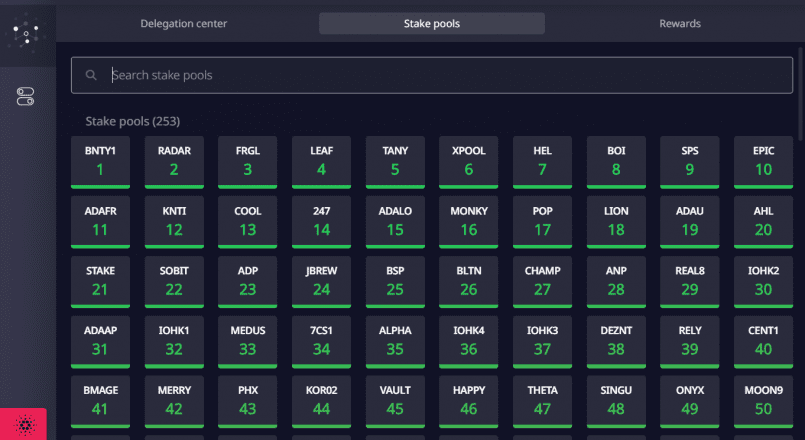Cardano Staking: Everything You Need to Know About ADA Returns
Cardano's Shelley upgrade introduces staking rewards, allowing ADA holders to earn interest.

Key Takeaways
- Cardano users could earn 4.5% per year by staking ADA
- Users can run their own stake pool or join an existing pool
- Cardano's staking model is designed to avoid centralization
Share this article
Cardano has launched its Shelley upgrade, which introduces staking rewards for users who hold the ADA cryptocurrency. Here’s what you can expect from Cardano’s staking features.
The Basics of Cardano Staking
If you decide to stake your Cardano (ADA tokens) for a set period of time, you’ll periodically earn a return on your investment. Staking also helps the Cardano network: it is the process by which validators are selected to create a new block and process transactions.

Cardano staking operates on a cyclical basis. Rewards are paid out every “epoch,” or every five days. During the network’s initial launch, there will be epochs in which no rewards are paid out.
Cardano addresses have separate keys for spending and staking. This means that if you decide to stake your ADA tokens, they will never leave your wallet. Plus, Cardano doesn’t require your tokens to be locked in for a term—you can un-stake your tokens at any time. This flexibility sets Cardano apart from its competitors.
Joining vs. Running a Pool
Cardano relies heavily on staking pools, whereas some other blockchains rely heavily on individual staking nodes.
Pools will ensure that Cardano’s validator network stays large: “If people could get rewards without operating a pool or delegating to one, then there might not be enough node operators to have a successful network,” an IOHK spokesperson told us.
Advanced users should run their own pool to earn higher profits. However, individual users can stake their tokens with an existing stake pool, which is a much simpler process. You can delegate tokens from your Daedalus or Yoroi wallet, as explained here.
What Do You Need To Run a Pool?
If you decide to operate a staking pool, you will need constant Internet connectivity, and you’ll need various technical skills. Cardano’s website says that pool administrations need to have:
- Operational knowledge of how to run and maintain a Cardano node on a 24/7 basis
- System operation skills
- Experience of development and operations (DevOps)
- Server administration skills (operational and maintenance)
You won’t need a powerful computer, and ASIC devices provide no advantage: unlike mining, staking requires only minimal power. You will, however, need reliable internet access.
You can run a pool without owning any ADA at all, in which case you would simply provide technical services to other users. By comparison, Ethereum will require nodes to stake at least 32 ETH.
What Do You Need to Join a Pool?
If you join a staking pool, you won’t need a constant Internet connection, and you won’t need to monitor your stake 24/7. There is no minimum staking amount on most pools.
However, you will need to choose a pool that is reliable and which offers low fees. Websites like PoolTool and Adapools allow users to view the status of each pool. Cardano’s Daedalus wallet also helps users choose a pool through its delegation screen:
Once you’ve staked your ADA, you don’t have to do anything at all: rewards are automatically paid out, and there is no need to make a claim. If you do not withdraw your original stake, your ADA will remain staked, and you will continue to earn rewards.
How Will Cardano Achieve Decentralization?
Cardano will ensure that its staking pools do not accumulate too much power. For one thing, Cardano’s stake pools will offer lower rewards as they get larger. This will encourage users to move between pools on a regular basis, and this will in turn theoretically prevent any pool from gaining dominance.
Secondly, Cardano’s staking pools will have little control over governance. “Stake pools don’t vote. Only the genesis key holders will be able to vote initially,” Cardano’s staking FAQ explains. This is explained in more detail in this forum post.
Cardano also planned to introduce enterprise addresses at one point, which would prevent exchanges from staking their ADA and dominating stake pools. However, Cardano has said little about enterprise addresses and they do not appear to be a current feature.
Cardano’s “Voltaire” phase, still under development, will introduce a more elaborate governance system in the future.
Is Cardano the Ideal Staking Platform?
Cardano is planning one of the most original—and possibly one of the most decentralized—staking models ever. It seems that rewards will be reasonably profitable, and Cardano’s focus on stake pools will make it easy for users to participate.
However, Cardano is often criticized for the fact that it took years to deliver its promised staking feature. In the mean time, several other blockchains have built a brand around staking, including Tezos, TRON, and Cosmos. Only Ethereum has faced as much criticism for its failure to deliver staking in a timely manner.
In Cardano’s defense, it did introduce staking with real value to early users during its testnet phase—meaning that the project actually delivered staking seven months sooner than it is given credit for.
Only time will tell whether Cardano’s staking rewards are enough to attract new users on a continual basis.
Share this article

